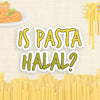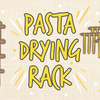Why Does Pasta Come In Different Shapes?

Pasta comes in different shapes to suit the various culinary needs in each pasta recipe. This is because the pasta absorbs soups and sauces at a different rate depending on its thickness and shape. While there are over 350 pasta varieties, this guide will categorize them depending on their shapes and user preference.
Not Much Time? Skip To What You'd Like To Learn...
What Is Pasta?
Pasta is an Italian dish consisting of dough that’s prepared using durum wheat and water. The dough gets extruded or stamped into the required shapes and can be cooked by boiling it in water. Pasta can be divided into two major categories: dried and fresh pasta. Dried varieties are produced and dried commercially via the extrusion process. Fresh varieties, on the other hand, are prepared by hand as per the traditional recipe. Further reading material: healthline.com.
Why Are There So Many Shapes?
Different Purposes - Different types of pasta are used for various dishes depending on their shapes. Thin pasta varieties such as angel hair match perfectly with thin oil-based sauce due to its size, while thicker sauces work best with heavier and thicker pasta. On the other hand, flat pasta pairs perfectly with cream sauces while round pasta is best matched with tomato-based sauces as they cling better.
Special Recipe Requirements - Specific recipes require unusual pasta shapes to fit perfectly with other ingredients. As a result, end up with particular varieties that match perfectly with soups while others are best used as a base of a salad. Large pasta shells can even be stuffed with a mixture of meat and vegetables or cheese.
Different Cultures - While it’s a popular misconception that all pasta originated from Italy, the earliest evidence points to 6000 years old pasta from the region of modern-day China. Over the ages, various cultures around the world perfected their unique noodles and pasta recipes depending on locally available ingredients and serving style.
Pasta Aesthetics - When it comes to presentation, pasta holds the top position for the highest number of variations. This is thanks to all the possible shapes that pasta can be prepared into. Pasta aesthetics plays a critical role in the presentation, which serves to entice your appetite.
Different Tastes And Textures - The variations in texture and tastes of pasta are as a result of exquisite preparation using premium ingredients. This is why some expensive pasta varieties have unique taste notes. The storage and preservation method used affects the texture of the pasta; hence why leftovers and takeout are never as good as fresh pasta. Further reading material: thedailymeal.com.
Pasta By Shapes
Long And Skinny
- Spaghetti
Spaghetti is a long and thin cylindrically shaped pasta that’s originally from Italy. Spaghetti is prepared using milled wheat flour or semolina and water. Using refined flour results in white pasta, but whole wheat flour can also be used. Spaghetti can match with an entire range of dishes such as sardines, cottage cheese, prawn, tomatoes, and just about any meal based sauce.
- Linguine
Linguine is prepared using wheat flour, eggs, and water making it similar to fettuccine with an elliptical shape and was traditionally served with sauces such as pesto. Linguine can also match with fish and tomato-based sauces. Linguine is available in both whole wheat and white flour versions, but the original recipe relied on durum wheat.
- Fusilli Lunghi
Fusilli Lunghi Bucati is originally from Campania and future a simple spiral shape. Traditionally, fusilli lunghi was prepared by rapidly twisting a strand of fresh spaghetti around a knitting needle. Fusilli lunghi was traditionally served with Neapolitan seafood dishes. This pasta variety is best served with sheep’s cheese or with tomato and vegetable sauce spiced with peppers and aubergines.
- Vermicelli
Vermicelli translates to little worms in Italian; this traditional pasta variety has a round shape just like spaghetti, although it’s typically thicker. Vermicelli is generally used to make savory and sweet dishes with chicken soup and will also match perfectly with stir-fries and soups.
- Capellini
Capellini is a very thin Italian pasta variety that’s between 0.85 and 0.92 mm. Capellini is also rod-shaped and is often packed in the form of long strands. The name literally translates to angel hair due to its thinness that’s perfect for savory soup dishes with vegetables.
- Bucatini
Bucatini, also referred to as perciatelli, is originally from Naples. Bucatini has an elongated shape and a hollow inside with a round cross-section. Due to their unique shape, Bucatini is famous with tomato sauce, sheep’s cheese, and pork cheek. Bucatini can also be quite versatile with sauces made with meat, fish, or butter.
Long Ribbons
- Tagliatelle
Tagliatelle is a traditional Italian pasta variety that’s originally from the Emilia-Romagna regions of Italy. Tagliatelle gets shaped into long flat ribbons that are similar to fettuccine and measure around 6.5 mm in width. Tagliatelle relies on a ratio of 100g of durum wheat semolina to one egg to give it its characteristic texture.
- Pappardelle
Pappardelle is large, flat pasta noodles with a broad shape that is originally from the Tuscany region of Italy. Pappardelle has wide ribbons that are ideal for thick sauces, especially meat-based ones.
- Fettuccine
Fettuccine translates to little ribbons. This traditional Italian pasta variety is most prevalent in Tuscan and Roman cuisine. The pasta has a flat and thick surface thanks to its one egg to 100 g of flour ratio. The fettuccine was classically consumed with beef ragù and chicken ragù.
- Mafaldine
Mafaldine is an Italian pasta variety, also known as little queens. These types of pasta have a ribbon-shaped design with a flat and wide surface and wavy edges. Mafaldine is often served with delicate sauces, especially vegetable and meat-based ones.
- Stringozzi
Stringozzi is an Italian wheat pasta variety that’s originally from the Umbria region. Stringozzi has a long and rectangular cross-section and is made by hand. Stringozzi is often served with black truffles, meat ragù, and tomato-based sauces.
- Trenette
Trenette is an Italian pasta variety that’s originally from Genoa and Liguria regions of Italy. Trenette has a flat and narrow shape and is often served with pesto- a dish that includes green beans and potatoes boiled in the same water.
Shells
- Conchiglie
Conchiglie is a type of Italian pasta that has a characteristic shell-like shape; in fact, the name translates to ‘seashells.’ Conchiglie is available in both plain durum wheat variety and colored varieties, which use tomato extract, spinach extract, and squid ink. Conchiglie is frequently used in pasta salads with meat sauces.
- Lumache
Lumache is a shell-shaped pasta variety that’s perfect for thin and thick sauces. Lumache has a hollow interior that’s usually filled with ricotta, mozzarella, and spinach before baking it in the oven.
- Lumaconi
Lumaconi is an Italian pasta variety that’s shaped like a snail shell just like lumache but with a much larger size. As a result, lumaconi pasta is often stuffed with ground beef, sausage, or just about any other minced meat.
Twists
- Fusilli
Fusilli or rotini is a twisted pasta variety that’s originally from Italy. Fusilli is formed into helical or corkscrew shapes by rolling a small rod over pasta strips, thus winding them around it in a corkscrew shape. Fusilli is available in both whole-wheat varieties and colored varieties, which require additional flavorings such as beetroot and tomato for red colors and spinach for green color. Fusilli is best consumed with smooth sauces such as pesto.
- Trofie
Trofie is a twisted pasta variety that’s short, twisted, and relatively thin. Trofie is originally from the Liguria region of northern Italy. Traditionally, trofie was prepared using wheat or chestnut flour and potatoes. In Italian cuisine, trofie is often served with pesto sauce.
- Strozzapreti
Strozzapreti is an Italian pasta variety whose name translates to priest strangler. Strozzapreti has an elongated shape with a twist making it perfect for thick sauces. Strozzapreti is originally from the Tuscany and Umbria regions of Italy. This pasta variety is often served with tomato and vegetable-based sauces.
- Caserecce
Caserecce is originally from the Sicily region of Italy and is pasta with short twists along the entire length so that they appear rolled upon themselves. The twisted shape significantly improves their sauce holding capabilities, making them perfect for chunky sauces made from basil, ricotta, or eggplants.
- Gemelli
Gemelli is a type of Italian pasta that’s recognizable due to its twin-like twists, which are, in fact, just a single s-shaped strand that’s twisted into a spiral. Gemelli is often used in salads and casseroles. Gemelli can also be served with marinara, pesto, brown butter, and Alfredo.
- Rotini
Rotini is a twisted pasta variety that’s originally from Italy. Rotini is formed into helical or corkscrew shapes by rolling a small rod over pasta strips, thus winding them around it in a corkscrew shape. Rotini is available in both whole-wheat varieties and colored varieties, which require additional flavorings such as beetroot and tomato for red colors and spinach for green color. Rotini is best consumed with smooth sauces such as pesto.
Tubes
- Penne
Penne is an extruded type of Italian pasta with pieces that are shaped like cylinders. Penne was first made in 1865 by Giovanni Battista Capurro, a pasta maker from Genoa. Penne is often served with pesto, marinara, and arrabbiata sauce.
- Rigatoni
Rigatoni is tube-shaped pasta that comes in varying diameters and lengths and is originally from Italy. Rigatoni characteristically has ridges along the entire length and depending on the manufacturer. They may also have spiraling patterns around the tubes of pasta. The adhesive surfaces of rigatoni make better surfaces for grated cheese and sauces.
- Macaroni
Macaroni is dry pasta that’s shaped like narrow tubes that are cut in short lengths and have a slight curve. Macaroni has an absorbent surface that easily adheres to thick sauces and is often served with cheese and tomato-based sauces.
- Paccheri
Paccheri is Italian pasta that’s shaped like a large tube that’s prepared using durum wheat flour. Generally, macaroni is served with rich sauces and heavier seafood. Paccheri can also be stuffed with ricotta and baked.
- Tortiglioni
Tortiglioni is a type of large pasta that’s similar to rigatoni but larger and with spiral grooves around the pasta. Tortiglioni is often served with succulent meat-based sauces or tomato, and vegetable sauces with oven-baked dished.
- Trenne
Trenne refers to short pasta varieties that are triangular shaped along the edges with a hollow center. Trenne pasta has rough ridges on the outside, which are great for chunky sauces and baking. Trenne is often served with thick meat sauces.
- Manicotti
Manicotti literally translates to a little sleeve. This Italian pasta is ridged along its surfaces for increased sauce absorption. The ridged pasta is often stuffed and baked with ricotta cheese, ground meat, or even chopped spinach. Manicotti is also best topped off with béchamel sauce or tomato sauce.
- Ditalini
Ditalini refers to an Italian pasta variety that's shaped like small tubes. Traditionally, ditalini was used in Sicilian dishes that included ricotta cheese and broccoli dishes. The small size of ditalini pasta makes the variety the best choice for soups that fit nicely on a spoon or for use in pasta salads.
- Cannelloni
Cannelloni are cylindrical lasagna varieties initially from Italy. Where they are generally stuffed with a filling before baking and served covered with a sauce, some of the best stuffing to use with cannelloni includes ricotta, spinach, and minced beef.
Mini Shapes
- Orzo
Orzo is an Italian pasta variety that’s a form of short-cut pasta almost the size of a large grain of rice. While orzo can be served alone in a soup, it can also be baked in a casserole or as part of a salad. Orzo is often colored by chilies, saffron, and black beans to yield the required color.
- Fregola
Fregola is a type of pasta from Sardinia island of Italy. It has a distinctive shape that typically consists of semolina dough that’s rolled into tiny 3 mm thick balls, which are then toasted in the oven. Fregola makes an excellent base for pasta salad and can even be mixed with orzo.
- Canestrini
Canestrini, also known as little baskets, is an Italian pasta variety that’s shaped like a basket. This unique shape is ideal for meat ragù sauces and fish sauces, which are thick enough to rest in the basket-like pasta.
- Stelline
Stelline are tiny star-shaped pasta varieties that are often used in soups due to their negligible size. Stelline is prepared using durum wheat flour and water with additional eggs to change the flavor and color. Stelline is especially great with chicken soup or any other meat soup.
- Risi
Risi looks like huge rice grains but is actually a type of Italian pasta. Like most dried pasta, risi is actually made from a mixture of semolina, durum flour, and water, which is then kneaded into a dough that’s then shaped and rolled flat. Risi has distinctive pointed ends and creamy color. Risi is mostly served with soups and stews, as well as meat-based sauces.
- Quadrettini
Quadrettini pasta variety future a square shape with a serrated margin and a creamy color thanks to the additional eggs used in the production process. Quadrettini pasta is often served with thick broth and meat-based sauces.
- Anelli
Anelli are tiny pasta rings of pasta that are generally used for soups and pasta salads. Anelli can also be used in baked recipes giving the tinny rings a creamy texture. Anelli is best served in soups such as beef and peas soup.
Filled Pasta
- Ravioli
Ravioli pasta is shaped into small envelopes that can be stuffed with minced meat, cheese, fish, or vegetables. Ravioli pasta is often served with spicy sauce or thick tomato sauce.
- Tortellini
Tortellini is a small ring-shaped pasta variety that is originally from the Emilia region in Italy. Traditionally, tortellini was stuffed with a mixture of meat, cheese, nutmeg, and eggs. Tortellini is best served in capon broth or any other meat-based broth.
- Cappelletti
Cappelletti, also known as little hats, are plump stuffed pasta varieties that are filled with minced meat. Cappelletti is best served with a rich capon or chicken broth.
- Agnolotti
Agnolotti is a pasta variety from the Piedmont region of Italy. Agnolotti is made with small flattened pieces of dough, which are then folded over a filling of vegetables or roasted meat. Agnolotti is best served with thick meat-based broths. Further reading material: tasteatlas.com.
Conclusion
With over 350 varieties of pasta available to try, every day should be a pasta day. With this pasta guide, you will have no problem picking the perfect combination for each meal.






